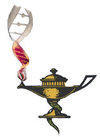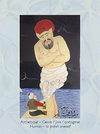ʻAlāʼ ad-Dīn and the Lamp: A Teaching Story of the Hidden Self

The story of ʻAlāʼ ad-Dīn (علاء الدين), better known as Aladdin, is a powerful allegory from
The Thousand and One Nights, a Middle Eastern collection of teaching stories passed down over centuries.
Though later Western versions romanticised it, the original tale is rich in psychological and spiritual meaning — likely influenced by Sufi tradition. It speaks to the process of uncovering our inner resources and waking to our hidden potential.
In the tale, ʻAlāʼ ad-Dīn is lured into a cave by a magician, which represents his animus (the male shadow within). Inside, he finds a neglected lamp — a symbol of a vessel that holds our capacity to transform, through polishing the lamp–ourselves. He travels into the darkness of the cave, an, descending many steps finds in a forgotten room, a lamp. He returns, but tempted by sparkling and enticing jewels, he pockets them, ignoring warnings, and is weighed down by their burden. When he tries to leave, he cannot. Only by rubbing a magical ring does he release a djinn who helps him escape. Later, when safely at his mother’s home, he takes out the lamp, and, on seeing how dirty it is, begins to polish it. Another djinn emerges from the lamp, catalysing his transformation.
The lamp represents our forgotten self — the vessel for our essence. The jewels symbolise inherited patterns, beliefs, or traumas that we mistake for value but which no longer serve us. The cave itself is the domain of the subconscious, a place we must enter to rediscover what was lost.
A Contemporary Parallel: The Brain’s Cleansing Cave
Neuroscience now describes a similar process: during deep sleep, the brain activates the glymphatic system, which flushes out toxins. The brain slightly contracts, allowing cerebrospinal fluid (CSF) to wash through neural tissues, removing waste products. This process may reduce the risk of Alzheimer’s and dementia.
In osteopathic and somatic traditions, this echoes the cranial rhythm — the brain’s subtle expansion and contraction, aligning with what we call the flexion-extension cycle. Like ʻAlāʼ ad-Dīn’s descent and return, our inner work involves contraction, awareness, and release.
Polishing the Vessel

When ʻAlāʼ ad-Dīn finally rubs the lamp, the second djinn appears. This act symbolises the polishing of our vessel — a practice of inner remembrance. In Arabic, ʻAlāʼ ad-Dīn means “excellence in faith”. Through surrender and presence, our shadows and strengths alike are illuminated. What once seemed worthless becomes the source of nourishment, guidance, and integrity.
The story continues to catalogue the gradual transformation of an immature, street-wise boy into a mature adult, known for his ethics, morality, integrity, and worship. He earns his name ‘excellence in religion’, an allegorical meaning that suggests if we polish our body, physiology (how we nurture ourselves), behaviour (our actions throughout our life), and mind (the thoughts that surround us), these augment epigenetic changes, activating potential within.
Glossary
- Sufi: A mystical branch of Islam focused on inner purification, love, and union with the Divine.
- Cave: A metaphor for the subconscious mind and ancestral memory.
- Lamp: Symbol of the vessel of our essence — often forgotten or casually acknowledged.
- Jewels: Represent inherited beliefs, family patterns, or conditioning that may no longer serve us.
- Djinn: From the Arabic root j-n-n, meaning “hidden”; represents transformative, concealed potential.
- Glymphatic system: A brain-wide fluid clearance system active during sleep, removing toxins and metabolic waste.
- Cerebrospinal Fluid (CSF): The fluid that cushions the brain and spinal cord and helps clear waste, and a dynamic neurology.
- Alzheimer’s: A neurodegenerative disorder associated with memory loss and cognitive decline.
- Dementia: A general term for the impaired ability to remember, think, or make decisions.
- Polishing (Dhikr): A spiritual practice of remembrance — turning attention back to the Divine or the essential self.